Terry L. Ettinger Horticulture Consulting Services
Meeting The Needs Of Today With A Vision For The Future
Question of the Week
Landscape Screening/Privacy Options
Q. Our new neighbors have turned into a real nuisance. They have every imaginable outdoor plaything for their three kids and invite their families to dinner and outdoor games like horseshoes and volleyball every weekend. They park a couple of disgusting trailers next to their garage, too!
It used to be so peaceful sitting on our patio, but now we need some sort of evergreen screen ASAP! What kind would you recommend?
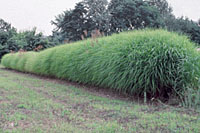 A. Unfortunately, you haven't provided enough information (sun or shade, wet soils or dry soils, the amount of space
available for a screen planting, presence of deer, etc.) for me to make a specific recommendation. However, let me offer a
couple of general thoughts.
A. Unfortunately, you haven't provided enough information (sun or shade, wet soils or dry soils, the amount of space
available for a screen planting, presence of deer, etc.) for me to make a specific recommendation. However, let me offer a
couple of general thoughts.
First, does the planting really need to be evergreen?
If you really only spend time on your patio from roughly the middle of May through the middle of September or even early October, then deciduous shrubs that leaf out in May can provide just as much privacy as evergreens. They often grow more quickly and can offer colorful spring flowers and fall foliage, as well as attractive fruit that persist long after the leaves drop. Some of the larger ornamental grasses, above right, can provide effective mid- through late summer screening, too!
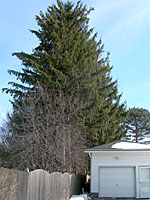 Second, resist the temptation to plant a straight-as-an-arrow row of evergreens within feet of your property line.
Second, resist the temptation to plant a straight-as-an-arrow row of evergreens within feet of your property line.
While they may be fairly small now, they will grow, and grow, and . . . . . , well, you get the picture. All of the
evergreens frequently planted for screening purposes (pines, spruce, hemlock, etc.), can easily spread twenty to thirty feet
over time, at left. They also tend to shed their lower branches with age, leaving you with a dense screen ten to fifty feet off the
ground, but only bare trunks spaced ten to fifteen feet apart that you can look
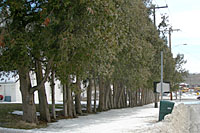 between right into your neighbor's back yard,
at right!
between right into your neighbor's back yard,
at right!
Therefore, my recommendation when it comes to installing plantings or building structures for privacy is to move them into your property, relatively close to outdoor living space(s) and/or windows, below left.
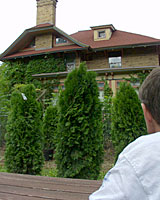 By doing this, you eliminate future potential conflicts over pruning property line-hugging hedges. And, you can often
create screens that are effective almost immediately with far fewer plants than you would otherwise need if they were
planted as a hedge along your property line.
By doing this, you eliminate future potential conflicts over pruning property line-hugging hedges. And, you can often
create screens that are effective almost immediately with far fewer plants than you would otherwise need if they were
planted as a hedge along your property line.
Moving screening materials into your property can also blur the perception of where your property ends and your neighbor’s begins.
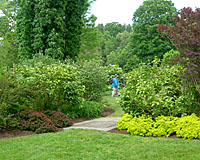 This may allow you to “borrow” the view of your neighbor’s beautiful Japanese maple tree, gazebo, or maybe even a garden
pond that’s half way across their backyard? By cleverly screening and framing the view near your outdoor living space,
you might be able to claim that tree as your own—without spending a dime,
at right!
This may allow you to “borrow” the view of your neighbor’s beautiful Japanese maple tree, gazebo, or maybe even a garden
pond that’s half way across their backyard? By cleverly screening and framing the view near your outdoor living space,
you might be able to claim that tree as your own—without spending a dime,
at right!